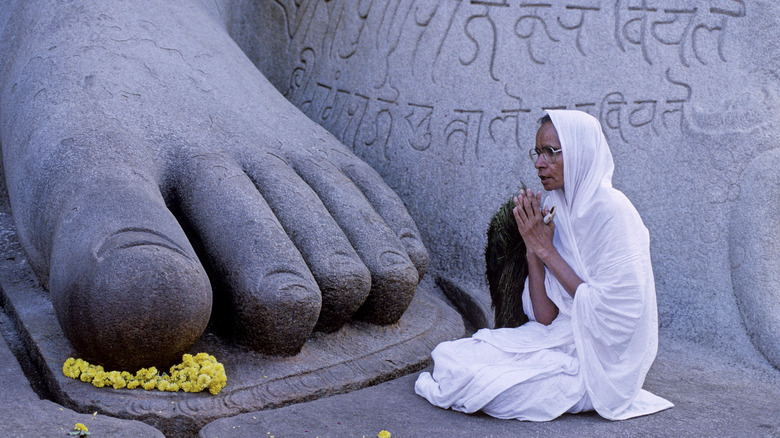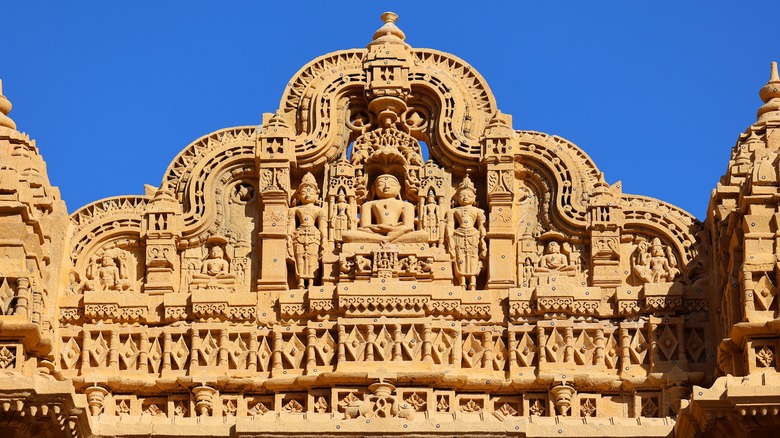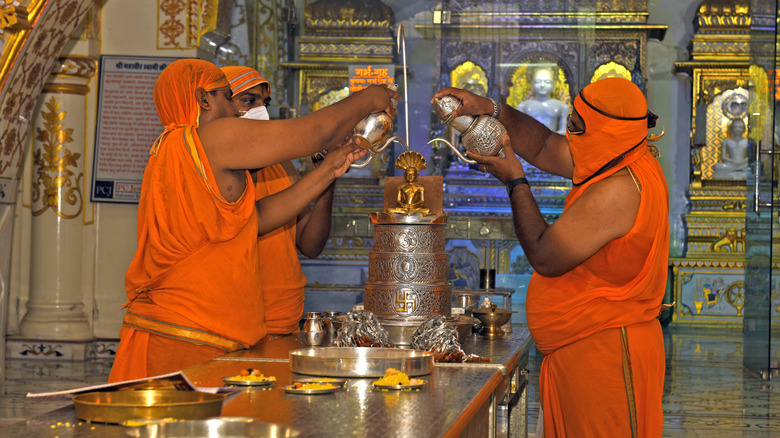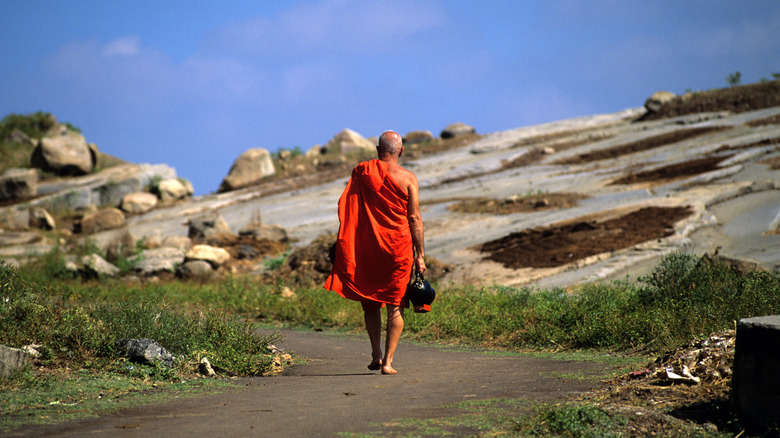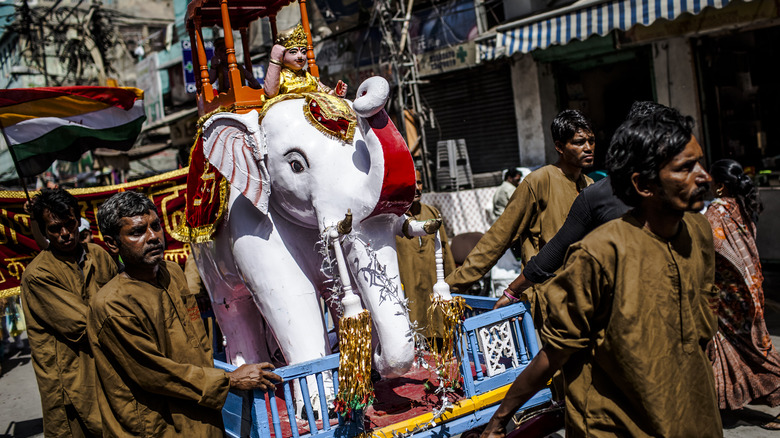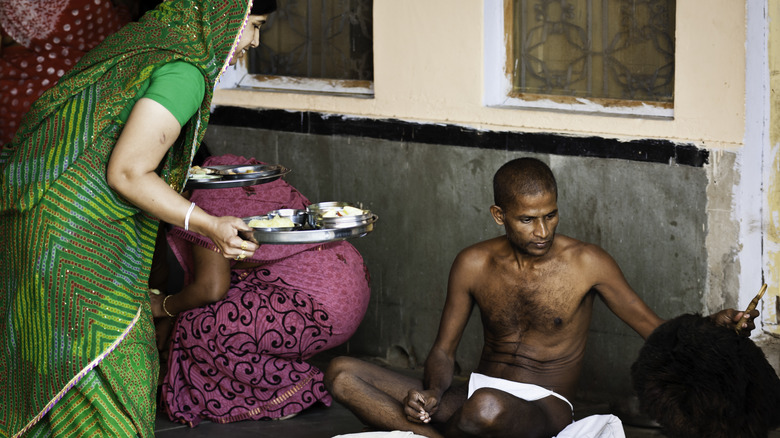What Is Jainism And What Do Its Followers Believe?
Though in the past it was often erroneously described as a branch of Hinduism or Buddhism, Jainism is considered by most modern scholars to be its own religion, with deep roots going as far back as the 7th century B.C. Today, the religion has more than 4 million adherents, mainly in West India, though the origin of Jainism is believed to be in the east of the country.
According to a recent study published by the Pew Research Center, Jains today are typically highly educated and socially mobile and feel a close affinity with Indian Hindus, who follow similar teachings in terms of beliefs around the soul. However, the same study reveals that Jains maintain a close-knit community, meaning that while they are today considered an affluent and integral part of Indian society, their beliefs and values remain little understood, either within India, where Jains make up just 0.4% of the population, or outside of it. Famously, devout Jains practice non-violence. However, though non-violence in Jainism is so expansive as to underpin the entirety of the Jain way of life, there is far more to their belief system in terms of the workings of the universe and how both devout practitioners and lay Jains ought to conduct themselves.
The Jain universe
Some sources claim that there is no supreme being in Jainism, suggesting that the religion is atheistic. Indeed, the focus of Jainism is glory of the infinite universe, which according to Jain teachings was always in existence, rather than created by a deity. But Jains do in fact believe in supernatural beings. The only difference in their beliefs compared to major theistic religions is that Jains believe that such beings transcend the universe as we know it, and are uncontactable: The religion is "transtheistic" in the words of the scholar Heinrich Zimmer in his influential book "The Philosophies of India." As a result, Jains believe that their spiritual development and enlightenment are in their own hands, to be secured through their actions rather than prayer or devotion.
Jains believe the universe, or "loka," is divided into five parts, with the beings most resembling gods in the highest chamber, other celestial beings below that, human beings in the middle, and the two chambers of hell below. Enlightenment is attained by ascending through these chambers after countless cycles of death and reincarnation.
According to Zimmer, western scholars initially credited the founding of Jainism to one man, Vardhamāna Mahāvīra, who lived in the time of Buddha in the 6th century B.C. However, Jains themselves consider Mahāvīra to be the last of a sequence of 24 founders who together carried Jainism down through the previous centuries. These founders are believed to have achieved kevala jnana, meaning they have achieved enlightenment and become Tirthankaras, the highest spiritual beings.
Karma
Karma is the system through which Jains believe they can ascend toward enlightenment on their spiritual journey. Nowadays, karma is something of a buzzword, being used everywhere from Reddit to animal-friendly product packaging. Westerners also evoke the concept of karma in general conversation whenever someone gets their comeuppance, or else a badly behaved person suffers a setback. But as in Buddhism — the religion that the concept of karma is most often associated with in popular culture — Jain karma has a very specific definition among believers.
Unlike the broad idea of karma as a mysterious process of justice, in the Jain belief system karma is considered a kind of material that becomes attached to a person through their beliefs and actions. Emotions such as anger attract karma, as well as ignoring the five vows that underpin Jainism. With too much karma weighing them down, the person remains in samsara — mortal life characterized by a cycle of reincarnation in various physical bodies both human and animal, as well as other existences, including that of a soul in hell or a deva — a celestial being. However, were a person to lead a life according to Jain teachings, they can eventually break free of the cycle to achieve kevala jnana.
The Vows of Jainism
Broadly speaking, the Jain religious community is divided into two strata: yatis, who are the monks and nuns of the religion, and sravakas, regular Jains who exist outside the monastic tradition.
Typically, yatis seek to live their lives according to the maha-vratas, or Five Great Vows. These are vows of absolute non-violence, absolute truth, absolute non-stealing, absolute celibacy, and absolute non-attachment to worldly items. In following these vows, yatis live an aesthetic life distinct from everyday Jain families. Yatis own no property, not even food, and rely on the offerings of Jains for sustenance and shelter.
According to Merriam-Webster, the word "sravaka" means "listener." Rather than the Five Great Vows taken by monks and nuns, sravakas take the Twelve Vows of Laity. Five of them are derived from the principles of the Five Great Vows, though more practical: Where the yatis' vows are absolute, these are less stringent. Beyond these are other vows which guide Jains in their everyday lives and strengthen them spiritually.
Jainism encourages a Multiplicity of Views
Some religions present an unshakeable view of the universe and how it works, as well as the moral code that human beings should abide by during their time on Earth. But Jainism teaches its practitioner that the world around us is far from simple, and that we are foolish to believe we can perceive it as a whole or understand its absolute truths from a single point of view.
There is a famous Jain parable concerning five blind men and an elephant. The men approach the creature from different angles, whereby they separately encounter its trunk, ear, leg, tail, and flank, which they separately perceive to be a tree, a fan, a pillar, a rope, and a wall. A sixth man intervenes, informing the blind men that they need to combine their information to get an impression of what an elephant really is.
This story illustrates the Jain concept of anekantavada, or "no-one-perspectivism," an outlook that suggests the truth is relative and that a multiplicity of views must be considered in all matters, both religious and secular. Jains typically share a willingness to learn the teachings of other religions, but resist religious dogma in a spirit of theological openness.
Non-violence
Undoubtedly the most famous aspect of Jainism is the strict vow of non-violence, known as ahimsa, undertaken by its monks and nuns, which in turn means practitioners must make a concerted effort to protect the lives of all creatures with which they come into contact. As well as disallowing violence between human beings, it also extends to the ideal of never knowingly causing pain to any living creature, whether big or small.
Jains as a rule are at least vegetarian, demonstrating their respect for animal life. Typically, Jains avoid honey for the sake of bees, as well as fermented products such as beer, as yeast is considered a living being. Even root vegetables such as potatoes are banned from the Jain diet, as Jain texts degree that pulling them from the ground is an act of violence. According to Learn Religions, most modern practitioners of the religion are vegan.
Some Jain monks and nuns go to far greater extremes to avoid taking the lives of living creatures. Strict observance of the rule of non-violence includes practitioners sweeping the ground in front of them as they walk to avoid stepping on tiny creatures in their path and walking barefoot. Such efforts are part of the Jain desire to live life according to the Three Jewels — right faith, right knowledge, and right conduct, through which a devout Jain may break the cycle of birth and death to achieve enlightenment and a state of kevala jnana, like the Tirthankaras.
